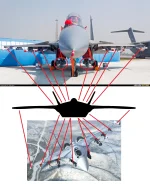- Views: 7K
- Replies: 35

The Indian Air Force (IAF) is embarking on a comprehensive upgrade program for its backbone fighter, the formidable Su-30MKI.
This extensive modernization effort, a collaboration between Hindustan Aeronautics Limited (HAL), the IAF, and private industry, seeks to bolster the capabilities of the IAF's workhorse multirole fighter.
The Challenge of Radar Visibility
A key focus of this upgrade initiative is addressing the Su-30MKI's radar signature.While a powerful and versatile aircraft, its substantial size (approximately 30 tons) results in a relatively large Radar Cross-Section (RCS). This means the Su-30MKI is more easily detectable by enemy long-range radars, potentially hindering its effectiveness in highly contested battlespaces where stealth is critical.
India's Innovative Solution: Radar Absorbing Paint
In response, India's Defence Laboratory, Jodhpur, has developed a technologically advanced solution – polyurethane-based Radar Absorbing Material (RAM) paint.This specialized paint incorporates magnetic functional fillers embedded within a polyurethane resin system. The combination offers multiple advantages:
- Superior Endurance: The polyurethane resin ensures the paint can withstand harsh weather conditions, including extreme heat and cold, maintaining its effectiveness over time.
- Optimized Absorption: The magnetic fillers are engineered with precise sizes and shapes to maximize the absorption of radar waves.
- Versatile Applications: This RAM paint is designed for use not only on the Su-30MKI, but also on other airborne platforms and even ground-based strategic assets.
Benefits for the Super-30
Though it will not render the Su-30MKI a true stealth fighter, RAM paint will considerably reduce its radar signature. This means enemy radars will have a more difficult time detecting the aircraft and will only be able to do so from shorter distances.Strategic application of RAM paint on high-RCS areas of the Su-30MKI, such as air intakes and leading edges, promises greater survivability in modern combat environments.
Coupled with other elements of the Super-30 upgrade program, this RCS reduction measure will help keep the IAF's fighter fleet a potent and relevant force well into the future.


